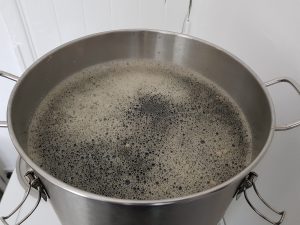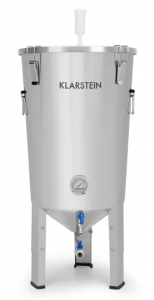Fermentation
 Fermentation is the process whereby yeast converts glucose in the wort to ethyl alcohol and carbon dioxide gas (CO2) to give beer its alcohol content and carbonation. Yeast is added (‘pitched’) to the cooled and oxygenated wort in the fermenter (see photo), and left to do its work for a few weeks. Yeast for home brewing is available in dried or liquid form (refer to the Yeast page). I’ve always used the dried sort wherever possible – this has always worked fine for me.
Fermentation is the process whereby yeast converts glucose in the wort to ethyl alcohol and carbon dioxide gas (CO2) to give beer its alcohol content and carbonation. Yeast is added (‘pitched’) to the cooled and oxygenated wort in the fermenter (see photo), and left to do its work for a few weeks. Yeast for home brewing is available in dried or liquid form (refer to the Yeast page). I’ve always used the dried sort wherever possible – this has always worked fine for me.
Some liquid yeasts advise the preparation of a ‘starter’. This is a kind of yeast ‘soup’ that lets the yeast multiply before you add it to the brew. The advantage of this is that the yeast is already active and beginning to multiply. To create a starter, add the yeast to a solution of dried malt extract (DME), in a sterilised container. This solution should then be agitated regularly (to introduce oxygen) over several hours (I prepare mine the day before a brew day) and then poured into the cooled wort that’s waiting in your fermenter. This really only applies to liquid yeasts, the dried variety already contain sufficient yeast cells to start the fermentation.
Before the yeast is pitched, the original gravity (OG) should be measured, with a hydrometer (or refractometer). This figure is used, after fermentation is complete, to calculate the alcohol content of the finished beer. If you are expecting a particular OG, and the measured OG falls short of this, the OG may be increased before the yeast is pitched by the addition of sugar or dried malt extract (DME). I use ‘brewing sugar’, which is dextrose monohydrate powdered glucose. Standard household sugar is sucrose (a mixture of glucose and fructose), which takes longer to be absorbed by the yeast, and which can produce bi-products and impurities and may affect the final taste. 500 gm of sugar will raise the OG by about 5 points in 25 litres.
It’s important to ensure that no air gets to the fermenting liquid, so that only the CO2 ‘sits’ on top of the liquid. So the fermenting vessel must be a sealed container, fitted with an airlock. The airlock contains a little water, through which the CO2 bubbles.
A signal that fermentation is complete is when the gravity of the beer remains constant for a few days – this is the ‘final gravity’. The alcohol content may now be calculated – refer to the Calculations page.
It’s worth leaving the fermenting beer in the fermenter for longer though to allow it to settle thoroughly. To further ensure that the beer is ultimately as clear as possible, it may be transferred (‘racked’) to a ‘secondary’ fermenting vessel, and left there for a further week or so before transferring it to a keg and/or bottles for conditioning.
At the end of fermentation, finings may be added to assist further in clearing the finished beer. I use Starbrite finings, in both the primary and secondary fermenters .
 I use a conical fermenting vessel. The design of this fermenting bin is such that the fermented beer may be run straight out through the tap into the keg (or bottles), removing the need to use a syphoning tube. It achieves this due to its conical shaped bottom, where the ‘trub’ gathers. The drain tap has an inner tube which may be angled so that just the clear (hopefully) beer is drawn off. There is also a drain connected right at the bottom of the cone, which allows trub to be drained off before transferring the fermented beer into keg/bottles. It also makes cleaning easier.
I use a conical fermenting vessel. The design of this fermenting bin is such that the fermented beer may be run straight out through the tap into the keg (or bottles), removing the need to use a syphoning tube. It achieves this due to its conical shaped bottom, where the ‘trub’ gathers. The drain tap has an inner tube which may be angled so that just the clear (hopefully) beer is drawn off. There is also a drain connected right at the bottom of the cone, which allows trub to be drained off before transferring the fermented beer into keg/bottles. It also makes cleaning easier.
Once fermentation is complete, dry hops may be added. From the point of clarity, it is better to add dry hops to the primary or secondary fermenting vessel as opposed to the keg. Hops should be sealed into a muslin bag, which is then submerged into the beer in the fermenter for 5 days or so. One problem with dry hopping is that it is very difficult to prevent the finished beer from being hazy. Many home brewers simply accept that hazy (cloudy) beer will always result from dry hopping – the beer still tastes the same whether it is hazy or not. If clear beer is preferred, once the hops have been removed from the fermenter, and prior to kegging / bottling, finings may be added. A solution of Glycerin is good at clearing beer after dry hopping.
